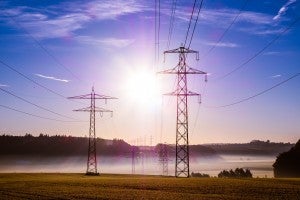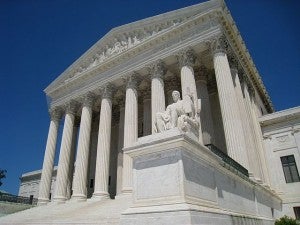 Last June, the Environmental Protection Agency (EPA) proposed the first ever national carbon pollution standards for existing power plants. Fossil fuel-fired power plants account for almost 40% of U.S. carbon dioxide emissions, making them the largest source of greenhouse gas emissions in the nation and one of the single largest categories of greenhouse gas sources in the world.
Last June, the Environmental Protection Agency (EPA) proposed the first ever national carbon pollution standards for existing power plants. Fossil fuel-fired power plants account for almost 40% of U.S. carbon dioxide emissions, making them the largest source of greenhouse gas emissions in the nation and one of the single largest categories of greenhouse gas sources in the world.
Under the Clean Power Plan, these emissions will decline to 30% below 2005 levels by 2030 – accompanied by a significant decline in other harmful pollutants from the power sector, such as sulfur dioxide and oxides of nitrogen. The power sector is already halfway to this target, already 15% below 2005 levels.
The EPA has carefully designed the Clean Power Plan to provide extensive flexibility so that states and power companies can continue to deliver a steady flow of electricity while deploying cost-effective measures to reduce carbon pollution over the next fifteen years.
The Clean Power Plan:
- Allows states and power companies to determine the optimal timing of emission reductions over a ten year-long averaging period starting in 2020;
- Allows states to decide how to most cost-effectively reduce carbon pollution, including through market-based programs and clean energy policies that have been successfully used around the country; and
- Allows states to cooperate with one another in complying with the long-term reduction goals.
In addition, the Clean Power Plan preserves the ability of grid operators to deploy long-standing tools and processes that have been successfully used in the past to keep the electric grid functioning reliability during periods of significant change. EDF has released a white paper identifying these well-established tools and practices, and describing how they will continue to ensure a reliable grid under the Clean Power Plan.
Grid operators are well-equipped to ensure reliability as we transition to a cleaner and more efficient power sector, just as they have under all previous Clean Air Act regulations. EPA’s proposed Clean Power Plan is eminently achievable, reliable, and cost-effective – and integral to our climate security, human health and prosperity.
Ample tools and practices exist to ensure a clean and reliable grid
Grid operators have long-standing tools and practices available to ensure that our nation’s grid continues to provide power reliably. These include well-established planning principles that have motivated large amounts of new generation year in, year out. Since 2000, roughly 30 gigawatts of new generation have been added per year, largely consisting of low or zero-emitting resources such as wind turbines and natural gas combined cycle power plants. Over the next two years, the solar industry alone expects to add another 20 gigawatts of power. In addition, reliability is ensured through tools and practices including:
- Transmission Upgrades: Because upgraded transmission infrastructure can help move generation more easily, transmission upgrades can enhance reliability without needing to add new generation.
- Long-term forecasting: Grid planners and reliability regulators forecast the needs of the electric grid years in advance. By determining how much transmission and generation will be needed, any long-term reliability issue can be identified and resolved quickly and effectively.
- Reliability Must-Run (“RMR”) Contracts: Short term contracts that, in the case of sudden and unexpected retirements or plant losses, require a unit to be kept operational until reliability can be ensured through the use of longer term tools.
- Operating Procedures: Manuals and standard practices exist to ensure that, in the case of particular reliability scenarios, grid operators know the best way to respond.
These tools are already in use throughout the country, and have proven extremely effective in maintaining reliability over the last few decades – even as the power sector has begun a rapid transition towards cleaner sources of electricity, and has implemented important public health protections under the Clean Air Act. In the Mid-Atlantic region, for example, roughly 12,500 MW of coal-fired power plant capacity retired from 2010 to 2014 due to economic reasons. Employing these well-established tools and practices, the region saw a large quantity of new resources added, without reducing reliability.
Clean energy resources and reliability
In complying with the Clean Power Plan, states and power companies will be able to draw on reliable, low-cost clean energy resources like demand response, renewable energy, and energy efficiency. Energy efficiency is almost three times cheaper than the next cheapest alternative and primed for enormous growth. Resources like demand response help prevent blackouts, such as in the case of the 2013 polar vortex. And renewable energy continues to grow, with states such as Maine, California, and Iowa already using it to meet close to one quarter of their entire demand.
No reliability crisis has resulted from implementing clean air standards
Claims that we can’t have clean air and a reliable power grid are as old as the Clean Air Act itself — and have never proven accurate. As far back as the 1970s, a power company issued an ad claiming the lights would go out as a result of the Clean Air Act. In recent years, some power companies that oppose public health protections under the Clean Air Act have made similar claims that the Mercury and Air Toxics Standards and Cross-State Air Pollution Rule will harm electric reliability.
These assertions have consistently been discredited: in the 45-year history of the Clean Air Act, no emission standard has ever caused the lights to go out. This is a testament both to the rigorous process and analyses EPA relies on to develop Clean Air Act standards, as well as the effective tools that grid operators and other authorities use to manage reliability on a short-term and long-term basis.
Numerous states, power companies, and reliability experts have indicated that the Clean Power Plan is achievable
A diverse collection of energy experts and power company officials have recently made comments noting the feasibility of achieving the emission reduction goals of the Clean Power Plan; describing their experience in reducing carbon emissions in a cost-effective way as well as explaining approaches to ensure reliability is maintained while making progress to reduce carbon emissions.
Written Testimony of Kathleen Barrón, Senior Vice President, Exelon Corporation, Before the Federal Energy Regulatory Commission: Technical Conference on EPA’s Clean Power Plan (Feb. 19, 2015):
Exelon strongly supports EPA’s goal of reducing carbon emissions from the electric power sector. As EPA notes in the Clean Power Plan, the current level of carbon emissions is environmentally unsustainable, and action must be taken now in order to prevent significant, irreversible environmental damage and major economic loss. By providing regulatory certainty, well-designed carbon reduction rules will be a driving force to modernize our aging electric system so that our customers will continue to have a safe and reliable electric system to support our Nation’s economic growth.”
Written Testimony of Susan F. Tierney, Ph.D, Analysis Group, Before the House Comm. on Energy and Commerce: Hearing to Examine EPA’s Proposed 111(d) Rule for Existing Power Plants (Apr. 14, 2015):
The Clean Power Plan provides states a wide range of compliance options and operational discretion that can prevent reliability issues while also reducing carbon pollution and compliance costs. Experience has shown that such approaches allow for seamless, reliable implementation of emissions-reduction targets. By contrast, many stakeholders’ concerns about the Clean Power Plan presume inflexible implementation, are based on worst-case scenarios, and assume that policy makers, regulators, and market participants will stand on the sidelines until it is too late to act. There is no historical basis for these assumptions.”
Joshua Epel, Chairman, Colorado Public Utilities Commission, Before the Federal Energy Regulatory Commission: Western Regional Technical Conference on EPA’s Clean Power Plan (Feb. 25, 2015).
In Colorado we have charted our own course to decarbonize our electric system. . . . Now when the Clean Power Plan is finalized I believe that Colorado as a state will come up with an approach which will meet the revised goals . . . . I’m very pleased with some of the steps we have taken with just approved unprecedented amounts of utility scale solar . . . . We are doing a lot with wind, we are doing a lot with innovat[ive] approaches actually passed by the legislature. . . . So we think there’s a lot of innovative tools for Colorado to use.”
Flexibility in the Clean Power Plan
EPA’s Clean Power Plan wholly preserves the ability of grid operators, power companies, and other institutions to deploy the well-established tools and practices that ensure the reliable operation of the power grid.
The Plan provides state-wide goals for emission reductions, while affording states ample flexibility in how those goals must be met. States are not limited to using any particular pathway to meet the Plan, and can deploy a variety of existing and new policies to meet the state-wide greenhouse gas reduction goals, including flexible market-based tools. This already existing flexibility allows grid operators the freedom to use long-standing and tested actions to ensure reliability.
Although the Clean Power Plan represents an important step forward for our country, it builds on a nation-wide trend toward a cleaner and more efficient power sector that is already under way. As noted above, carbon emissions from the power sector are already 15% lower than in 2005 – reflecting a sharp decline in coal-fired power generation, as well as a significant increase in natural gas generation and renewables and rising investment in energy efficiency.
Since 2005, many fossil fuel-fired power plants have also installed modern pollution controls in response to state and federal clean air standards adopted to protect public health from harmful particulates, ozone-forming pollution, and toxic air pollutants such as mercury and arsenic.
The robust system of reliability safeguards described above has responded deftly to these developments, ensuring a consistent and reliable supply of affordable power while helping reduce harmful air pollution. There is every reason to believe that the Clean Power Plan, with its extended implementation timeframe and numerous compliance flexibilities, will similarly achieve important reductions in air pollution without compromising electric reliability.
For more information please read our white paper: Protective Carbon Pollution Standards and Electric Reliability












